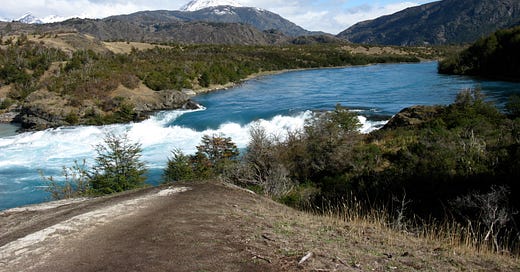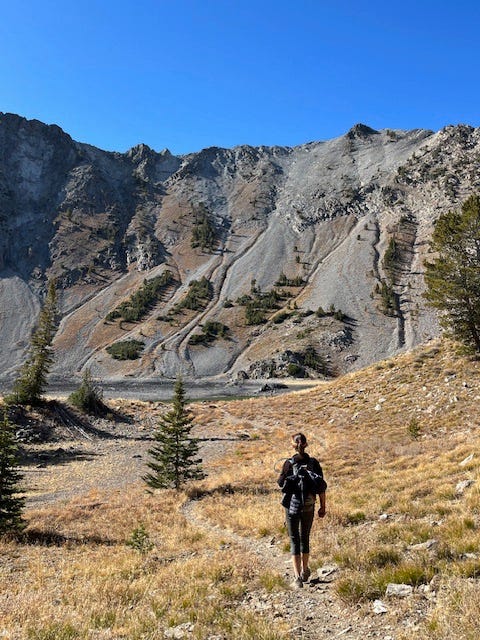“Everything in nature invites us constantly to be what we are. We are often like rivers: careless and forceful, timid and dangerous, lucid and muddied, eddying, gleaming, still.”
~Gretel Ehrlich in The Solace of Open Spaces
When I need a reminder of how to be, why I’m here, what it all means, a dose of connectivity, a respite—or an off-ramp entirely—from the overwhelming chaos of our present-day society, I turn to the natural world. In fact, I prefer to reside there more often than not. To run in spaces where the wind sweeps these questions and burdens to the background and the smell of dry grass in autumn calls forth my true nature, where endless star-strewn skies reveal the inherent truths of the world. Where I innately know how to be.
In her book, Braiding Sweetgrass, Robin Wall Kimmerer weaves together inherited Indigenous wisdom—which values connection and interdependence—with the science of botany to show us a more complete way of knowing. Her ancestral tongue Potawatomi is replete with what she calls the “grammar of animacy”, where the beingness of all life forms is recognized in language. Concepts that take the form of nouns in more common world languages are instead expressed as verbs: One says “to be a bay”, “to be a hill”, “to be a sandy beach”, recognizing the life in these natural forms. She says of a bay:
A bay is a noun only if water is dead. When bay is a noun, it is defined by humans, trapped between its shores and contained by the word. But the verb wiikwegamaa—to be a bay—releases the water from bondage and lets it live. “To be a bay” holds the wonder that, for this moment, the living water has decided to shelter itself between these shores, conversing with cedar roots and a flock of baby mergansers. Because it could do otherwise—become a stream or an ocean or a waterfall, and there are verbs for that, too. To be a hill, to be a sandy beach, to be a Saturday, all are possible verbs in a world where everything is alive. Water, land, and even a day, the language a mirror for seeing the animacy of the world, the life that pulses through all things, through pines and nuthatches and mushrooms. This is the language I hear in the woods; this is the language that lets us speak of what wells up all around us.
For so many of us, the comforts and ease of modern living have largely disconnected us from the rhythms of the natural world. While our comforts are, well, comfortable, our concurrent losses are incalculable. We've lost connection with our own deep intuition, forgotten how to heal ourselves, placed our somatic knowledge on the shelf. We miss out on the lessons offered by trees communicating with each other, the healing extended by natural hot springs and cold waters, the gifts of awe granted by expansive horizons. In the process, we’ve forgotten how to be. To be a woman, to be love, to be of this world. We refrain from fully expressing ourselves. Refrain from being free, dancing under the moonlight, saying what we actually mean. And we suffer as a result.
In his body of work, Dr. James Doty, Stanford neuroscientist and founder of the Stanford Center for Compassion and Altruism Research and Education, teaches that our species’ capacity for complex language and abstract thinking comes with the requirement that we caretake our young for several decades, and we’re hardwired to do so. Yes, we are hardwired for altruism and compassion. Oxytocin—the love drug—is what propels us to nurture and care, procreate, and build supportive relationships and communities. This hormone is produced when our parasympathetic nervous system is engaged—when we do all those things that feel inherently calming and connecting: walking in nature, hugging a loved one, snuggling with a pet, listening to music, meditating, placing our bare feet on the earth, taking a hot bath.
The problem is, the demands of modern society overwhelm our inherent capacities to navigate our environment (see How to Be Well in a Time of Evolutionary Mismatch), and we find ourselves in a near-constant state of “fight, flight, or freeze”, residing in our more primitive sympathetic nervous systems, rather than our parasympathetic ones. And, we do so not intermittently, as did our distant ancestors, but chronically. When we operate from this place of anxiety, we withdraw and become less adept at communicating, less creative, less compassionate, and more reactive, defensive, aggressive even. Our connection to knowingness dissipates and our ability to be, to just be, in the ways we are meant to, becomes obscured, sometimes nearly obliterated. The resulting individual and collective trauma, in large part, fuels the litany of social ills on full display today.
I often think about how we are the only organisms on the planet who seem to have forgotten how to be. Each and every other species just does its thing—honeybees waggle dance to signify the location of a food source, fish swim towards light, spiders weave their glorious webs, birds fly south in winter along well-worn migratory flight paths. Each is innately responding to its environment, following the instructions set out in its DNA. Each is fulfilling critical functions to ensure its survival and the propagation of its species. Each is performing a unique and incalculably important purpose that, in concert with all the other beings performing their equally-important purposes, makes the world go round. In this world, none are confused, none are questioning purpose, none are assigning hierarchy. They are all just being—being their most glorious selves—together weaving this beautiful, awe-inspiring, love-filled and mysterious journey we’re on.
We, too, have this in our DNA. Buried deep inside, we know who we are. We know what to do. We know how to be, how to love, how to share, how to build a beautiful, reciprocal world that nurtures and honors all. But, somehow, we’ve gone very far astray, to a place that is not just breaking our hearts, but is threatening the very survival of every single species on this planet, including our own.
The good news is you can begin to change this by rekindling your connection to the natural world and, simultaneously, to yourself. I invite you to take steps, no matter how small, to venture out. Take a walk in the woods, observe the life forms in your yard, spend some time with your houseplants even. Try to pay attention in a deeper way to all that’s around you. Open your mind, relax your body, breathe. Intentionally engage each of your five senses—taking in the deep earthy smell of a rich loam, feeling a breeze brush your skin, quietly watching a hummingbird dart to and fro, listening to the lap-lap-lap of a lake caressing its shore, enjoying the sweet, floral taste of a wild strawberry. Be with this place, these beings, this energy. And, if you pay attention, there just may be some softer messages awaiting you, calling you back to yourself, guiding you to just be. The more you commit to these practices, the more they’ll become a part of you and the better able you’ll be to tap into your innate wisdom, to be your most glorious self.
And, with that, I’m off to be with the hills, the wind, the trees. I’m off to be me.
xo Wendy
P.S. I’m interested to hear from you—and I’m guessing you’d like to hear from each other! Do you have questions? Particular topics you’d like to hear more about? Things that are on your mind? Please share them in the Comments section!







I grew up in Europe and the east and west coasts. I fell in love with Chicago as it felt most like Europe.
I love that you describe her the way I do! I call her the lake that thinks she's an ocean 🌊